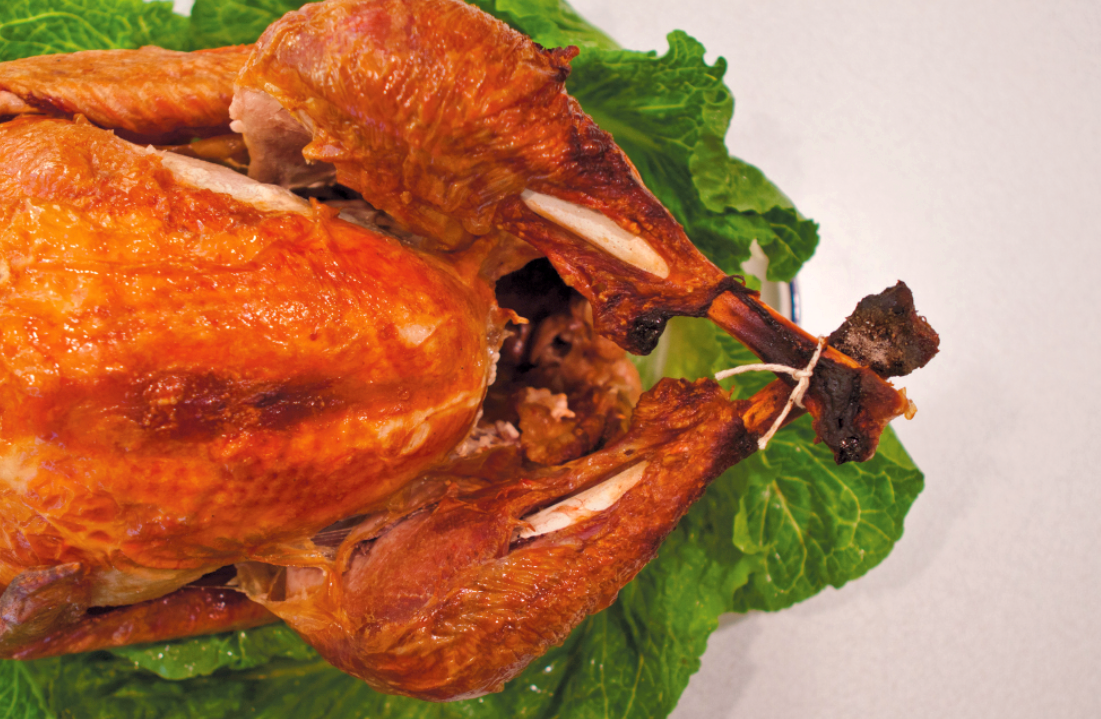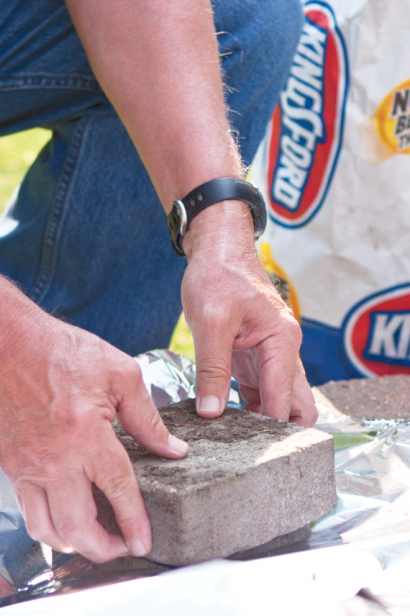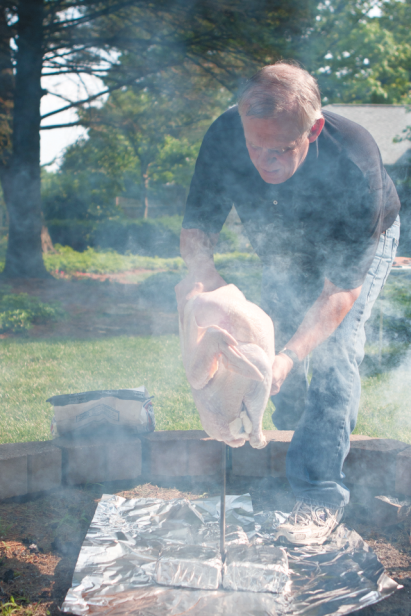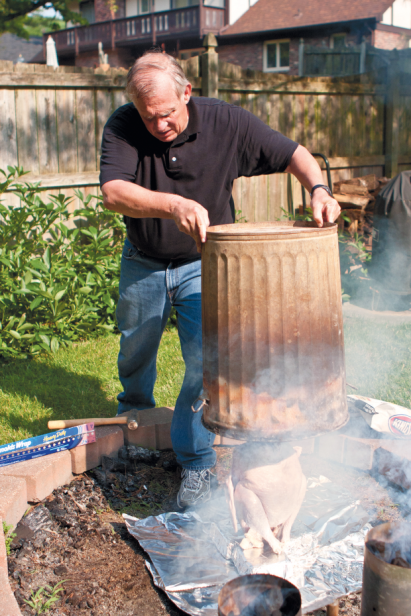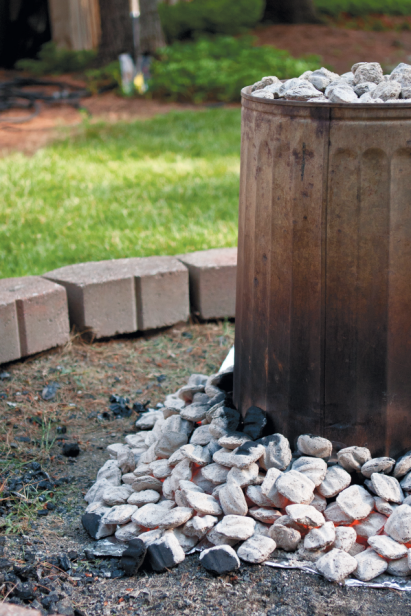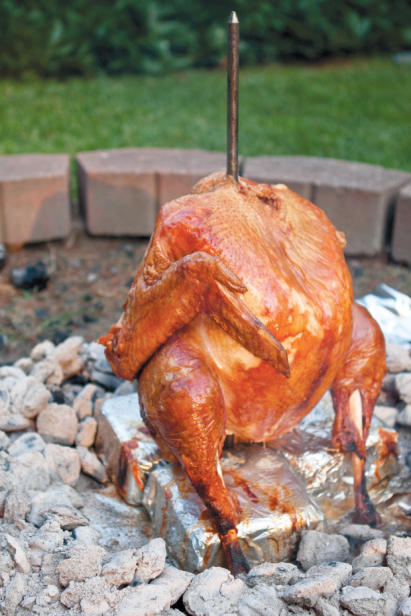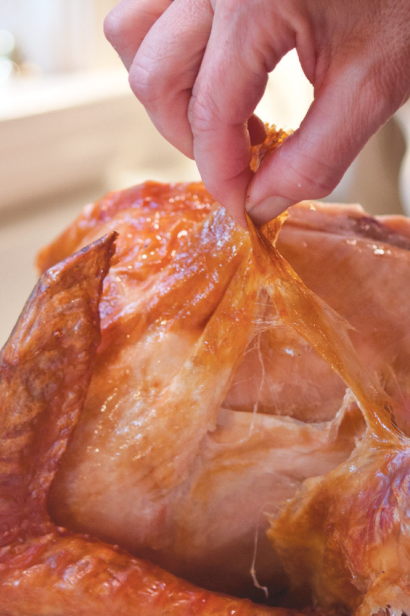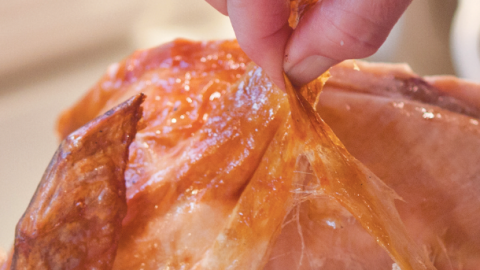A Turkey So Good, You'll Never Guess Where It Came From
Every Thanksgiving turkey makes the inevitable journey from show-stopping dinner table centerpiece to refrigerated leftovers to sandwich scraps and maybe to soup stock, but always ending in the same place: the household garbage.
In the Indianapolis home of Bob and Beth Groves, though, the turkey starts out in the trashcan.
Trashcan turkey, a decidedly unorthodox cooking method with a small but staunch group of devotees, is how the Groves put the heat to their meat at Thanksgiving for the past 15 years. Every November they cook two 20-plus-pound birds in old-fashioned metal trashcans for their family feast, which averages around 35 very eager eaters.
Using just a steel can, metal stake, aluminum foil and 40 pounds of charcoal, the Groves can cook a massive turkey outdoors in two hours flat – which has the added benefit of freeing up the kitchen for preparation of side dishes.
"It's moist and it's tender and it looks great. Everybody just seems to like it better," Bob says.
Trashcan turkey is familiar to regular attendees of the Sullivan Hardware & Garden TurkeyFest, held each year on the Saturday before Thanksgiving. It's a mecca of birds grilled or deep-fried, and the Groves are there to represent the trashcan contingent every year.
WACKY, BUT IT WORKS
Like beer-can chicken and other oddball poultry-cooking methods, trashcan turkey's origins are murky, lying somewhere between hillbilly legend and improvisational camping technique.
Perhaps hunters who bagged a wild bird wanted to eat it right away, and made do with whatever materials they had in their truck. Or perhaps its inception happened in an RV park, where full-size ovens were lacking. Some say it's a Creole recipe that started in New Orleans and moved north; others claim it's an old Boy Scout trick.
It does seem that people of a technical bent are particularly drawn to the method, with its mix of ingenuity and wackiness. That's how the Groves came across it.
"I'm an engineer, I'm not a cook," says Bob, 64, who works at Raytheon.
Their son Patrick was studying at the Coast Guard Academy in 1996 when his thermodynamics instructor challenged the class to test the method, offering extra-credit points. The Groves decided to give the experiment a try, with another turkey in the oven as a backup.
Their Thanksgiving party overwhelmingly preferred the trashcan bird to the traditional roaster, and they've been cooking turkeys that way ever since.
The trashcan is a hit at TurkeyFest, too. Sullivan storeowner Pat Sullivan calls the event a celebration of alternative methods for cooking turkeys, and even with flashier methods like infrared frying on display, the approach adopted by Groves and others feels special.
"Grilling and smoking works well for turkeys, but I still prefer trashcan turkey," Sullivan says. "There's nothing better than standing around an 800° trashcan on a crisp Thanksgiving day, enjoying a glass of beer or wine with family and friends."
HOW IT'S DONE
Because the turkey cooks at such a high temperature – Bob estimates it gets to 600° inside the can – you can't put any oil or butter or dry herb rubs on the exterior. If you do, it'll just char into an unrecognizable and icky-tasting crust.
Trashcan turkey may sound intimidating, but the Groves say once you've got the method down, it's the height of simplicity.
The first time you'll need a new steel trashcan, preferably 30 gallons. Burn off any chemical coating by starting a large fire in it that you let get good and hot. Then clean it out with water and maybe a little vinegar and let dry. (If you're going to cook any future turkeys, you should set this can aside and not let garbage near it.)
In a fire pit or dirt area, spread some heavy-duty aluminum foil about three feet square. Don't do it on the lawn because you'll scorch your grass, and affect the taste of the turkey.
Next you'll need a steel stake, sharpened on both ends. Poke one end in the ground, and slide the turkey drumsticks-down – "Up from his butt and out through his neck," Bob says – all the way. If the ground is cold, consider the Groves' trick of putting some foil-wrapped bricks around the stake for the turkey to rest on.
Lower the trashcan upside-down over the staked bird. Light about six to seven pounds of charcoal. (Bob heats his in a pair of chimney starters before staking his turkey.) When the coals get ashy and hot, spread a single layer on top, across the bottom of the can, and layer the rest on the ground around the perimeter.
Next, pile the remaining unlit coals along the sides of the can, and . . . walk away.
That's all there is to it. There's nothing else to do until it's time to remove the can (using thick gloves), unstake the bird and carve it.
NO PEEKING
The heat coming off the can is tremendous – one can feel it from 10 feet away. Toward the end of the cooking time, a loud scintillating sizzle can be heard from underneath.
Resist the temptation to lift the can up and peek, the Groves say, because you'll lose the built-up heat. It takes exactly two hours to fully cook a 22-pound bird; for smaller sizes you'll have to experiment to find the right time.
As with cooking any large piece of meat, check it with thermometer inserted into the deepest flesh to ensure that it has reached a safe internal temperature.
Beth Groves mixes up gravy – about a gallon's worth – using the giblets. But for those who fret about not being able to incorporate the drippings, there is a solution: Try using a Bundt cake pan, with the turkey staked through the hole, to catch the juices. As with the trashcan, you'll need to burn off any finish first, and dedicate the pan to turkey duty only.
THE TASTE TEST
All right, you're thinking, maybe Trashcan Turkey isn't as crazy as it sounded. But how does it taste?
The flavor is unadorned, but heavenly. Because trashcan turkey is unencumbered by even the barest of seasonings, it's all about the juicy tenderness of the flesh contrasted with a succulently crispy skin – which, we might add, is nearly impossible to avoid picking at during the carving process.
Since the coals are separated from the turkey by the can, there isn't a strong smoky flavor. And because the turkey is spitted upside-down, you don't use a stuffing to imbue it with an herb-y aroma.
The best way to describe it is the truest turkey you're ever likely to taste. This is one pure bird.
TURKEYFEST AT SULLIVAN HARDWARE AND GARDEN
Curious about the trashcan technique? Watch how Bob Groves gets it done at TurkeyFest at Sullivan Hardware and Garden, held the Saturday before Thanksgiving. Groves joins other Indy residents at the annual event to cook turkeys in a variety of ways – smoked inside a Big Green Egg, grilled, roasted over an open fire and more. Attendees can sample it all, but be prompt – birds this good don't last long.
TurkeyFest started as part of a WIBC radio show cooking segment in 1997, with Sullivan owner Pat Sullivan filling in for a vacationing host. It moved to the store the next year and has been growing ever since.


